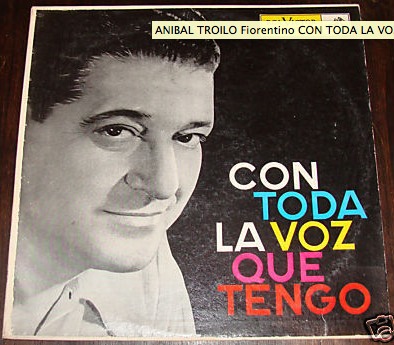
This weeks traditional tanda features some classic milongas by Anibal Troilo with Francisco Fiorentino singing.
More about:
| Home > Tango Resources > Tangology 101 Blog |

This weeks traditional tanda features some classic milongas by Anibal Troilo with Francisco Fiorentino singing.
More about:
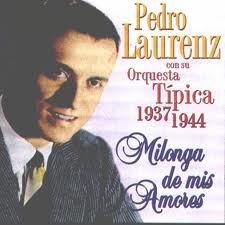
This weeks tanda is a collection of milongas by Pedro Laurenz.
More about:
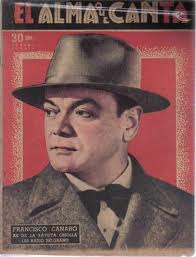
This weeks tanda is a collection of milongas by Francisco Canaro. These three milongas are very spirited. Somtimes you might start with a slower tempo milonga and then build, but in this set I start out right away with a fast milonga. So, if people don't like fast milongas, they will know not to dance this tanda.
More about:
| Song | Orchestra | Cantor/Singer | Year | Type | |
| Alternative Milonga Tandas |
|||||
| Fox Trot "Milonga" Tandas | |||||
| Listen to this Tanda | |||||
| Danza Húngara n.5 | Enrique Rodriguez | Armando Moreno | Fox Trot | ||
| Diez Soldaditos | Enrique Rodriguez | Armando Moreno | Fox Trot | ||
| La Colegiala | Enrique Rodriguez | Roberto Flores | Fox Trot | ||
| Por Las Calles de Instanbul | Enrique Rodriguez | Armando Moreno | Fox Trot | ||
| Marcelina | Enrique Rodriguez | Armando Moreno | Fox Trot | ||
| Yo Busco Una Novia | Enrique Rodriguez | Armando Moreno | Fox Trot | ||
| Luna Veneciana | Enrique Rodriguez | Armando Moreno | Fox Trot | ||
| Alternative Milonga Tandas | |||||
| Listen to this Tanda | |||||
| Al Galope | Color Tango | Milonga | |||
| Milonga Sentimental | Lidia Borda, Estaban Morgado Brian Chambouleyron |
Milonga | |||
| Morena | Estaban Morgado | Milonga | |||
| I like the first 3 in this set the best... The one with Iggy Pop is completely silly but fun. | |||||
| Sur O No Sur | Kevin Johansen | ||||
| Maki Maki | Goran Bregovic | ||||
| This Is A Film (feat. Iggy Pop) | Goran Bregovic | ||||
| This is A Film | Arizona Dream | ||||
| Balamouk | Les Yeux Noirs | ||||
| Listen to this tanda | |||||
| Leonel, El Feo | Bajofondo Tango Club | ||||
| El Llorón | Electrocutango | ||||
| Pequeño Paria or Narigon | Daniel Melingo | ||||
| Milonga Triste | Hugo Diaz | ||||
| El Lloron | Hugo Diaz | ||||
| Taquito Militar | Hugo Diaz | ||||
| The Way You Move | Outkast | ||||
| 19-2000 | Gorillaz | ||||
| Clint Eastwood | Gorillaz | ||||
| Petite Fleur | Chris Barber | ||||
| Fibre de Verre | Paris Combo | ||||
| Fleur Blanche | Orsten | ||||
| Summertime (Doin' Time) | Sublime | ||||
| What I Got (Reprise) | Sublime | ||||
| Santeria | Sublime | ||||
| Leonel, El Feo | Bajofondo Tango Club | Daniel Melingo | |||
| Noche Transfigurada | Daniel Melingo | Daniel Melingo | |||
| Narigon | Daniel Melingo | Daniel Melingo | |||
| Electronic Milongas | |||||
| Leonel, El Feo | Bajofondo Tango Club | Daniel Melingo | |||
| Mi-Lon-Gone | Korey Ireland | ||||
| Narigon | Daniel Melingo | ||||
| Leonel, El Feo | Bajofondo Tango Club | Daniel Melingo | |||
| Zitarrosa | Bajofondo Tango Club | ||||
| Tango, Que Misterio | Tango Jointz | ||||
| Silueta Porteña | Trio Garufa | ||||
| Milonga Sentimental | Otros Aires | ||||
| El Llorón | Electrocutango | ||||
| Rotos En El Raval | Otros Aires | ||||
| Junto A Las Piedraz | Otros Aires | ||||
| Leonel, El Feo | Bajofondo Tango Club | Daniel Melingo | |||
| Milonga Sentimental | Metro Tango | ||||
| Rotos En El Raval | Otros Aires | ||||
| El Andén | Bajofondo Tango Club | ||||
| Mi Corazón | Bajofondo Tango Club | ||||
| Miles de Pasajeros | Bajofondo Tango Club | ||||
| El Llorón | Electrocutango | ||||
| Quisiera Volver a Verte | Bailongo! | ||||
| Postales | Federico Aubele | ||||
| Sin Rumbo | Otros Aires | ||||
| Un Baile Beneficio | Otros Aires | ||||
| Song | Orchestra | Cantor/Singer | Year | Type |
| Mixed Orchestra Milonga Tandas |
||||
| Saca Chispas | Julio de Caro | Hector Farrel | 1938 | Milonga |
| Milonga Oriental | Angel Sica | 1942 | Milonga | |
| Señores Yo Soy del Centro | Lucio Demare | Horacio Quintana | 1944 | Milonga |
| Campo Afuera | Edgardo Donato | Horacio Lagos | ? | Milonga |
| La Cicatriz | Juan d'Arienzo | Alberto Echague | 1939 | Milonga |
| Qué Tiempo Aquel | Francisco Lomuto | Jorge Omar | 1938 | Milonga |
| El Portenito | Angel d'Agostino | Angel Vargas | 1943 | Milonga |
| Milonga Vieja Milonga | Juan d'Arienzo | 1937 | Milonga | |
| Milonga Compadre | Pedro Laurenz | Juan Carlos Casas | 1938 | Milonga |
| Milonga Que Peina Canas | Miguel Caló | Raul Beron | 1942 | Milonga |
| Milonga Brava | Francisco Canaro | Roberto Maida | 1938 | Milonga |
| Yo Soy De San Telmo | Pedro Laurenz | Alberto Podesta | 1943 | Milonga |
| Campo Afuera | Rodolfo Biagi | Teofilo Ibanez | 1939 | Milonga |
| La Milonga de Buenos Aires | Francisco Canaro | Ernesto Fama | 1939 | Milonga |
| Milonga Que Peina Canas | Juan d'Arienzo | Armando Laborde | 1952 | Milonga |
| Un Baile a Beneficio | Osvaldo Pugliese | Jorge Vidal | 1950 | Milonga |
| Milonga de Mi Tierra | Osvaldo Pugliese | Jorge Rubino | 1943 | Milonga |
| Mariana | Ricardo Malerba | Orlando Medina | 1942 | Milonga |
| Milonga Nueva | Jose Tinelli | Luis Mendoza | 1938 | Milonga |
| Mi Morocha | Ricardo Tanturi | Alberto Castillo | 1941 | Milonga |
| Candombe Milonga Tandas | ||||
| Candombe | Francisco Canaro | Alberto Arenas | 1943 | Candombe |
| Candombe Criollo | Francisco Canaro | Carlos Roldan | 1942 | Candombe |
| Azabache | Miguel Caló | Raul Beron | 1942 | Candombe |
| Candombe | Francisco Canaro | Alberto Arenas | 1943 | Candombe |
| La Negrita Candombe | Francisco Canaro | Carlos Roldan | 1943 | Candombe |
| Estampa del 800 | Francisco Canaro | Carlos Roldan | 1943 | Candombe |
| Caran Can Fú | Francisco Canaro | ? | ? | Candombe |
| Café | Alberto Castillo | Alberto Castillo | 1943 | Candombe |
| Al Aguatero Porteno | Alberto Castillo | Alberto Castillo | Candombe | |
| Charol | Alberto Castillo | Alberto Castillo | Candombe | |
| Papá Baltasar | Aníbal Troilo | Francisco Fiorentino | 1942 | Candombe |
| Carnavalito | Lucio Demare | Raul Beron | 1943 | Candombe |
| La Rumbita Candombe | Enrique Rodriguez | Armando Moreno | Candombe | |
| El Tucu Tun | Enrique Rodriguez | Armando Moreno | Candombe | |
| Azabache | Francisco Lomuto | Fernando Díaz y Jorge Omar |
1942 | Candombe |
| Candombe | Francisco Lomuto | Carlos Galarce | 1943 | Candombe |
| El Chino Pantaleon | Carlos Roldan | Candombe | ||
| La Rumbita Candombe | Osvaldo Fresedo | Oscar Serpa | 1943 | Candombe |
| San Domingo | Julio Sosa | Candombe | ||
| Negra María | Osvaldo Fresedo | Carlos Roldan | 1941 | Candombe |
| Tango Negro | Juan Carlos Caceres | Candombe | ||
| Toca Tango | Juan Carlos Caceres | Candombe | ||
| Me Llaman Luna | Sandra Luna | Candombe | ||
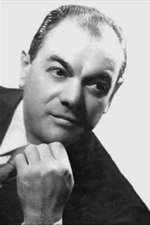
| Song | Orchestra | Cantor/Singer | Year | Type |
| These songs can be arrange in several different orders to make a grea tanda. I would normally play the first 3 or the last 3. |
||||
| Negrito | Francisco Canaro | Carlos Galán | 1934 | Milonga |
| Largas Las Penas | Francisco Canaro | Roberto Maida | 1937 | Milonga |
| Milonga Del 900 | Francisco Canaro | Ernesto Fama | 1933 | Milonga |
| Milonga Sentimental | Francisco Canaro | Ernesto Fama | 1933 | Milonga |
| Tangón (Nueva Danza) | Francisco Canaro | Roberto Maida | 1935 | Milonga |
| Largas las Penas | Francisco Canaro | Roberto Maida | 1937 | Milonga |
| Milonga Criolla | Francisco Canaro | Roberto Maida | 1936 | Milonga |
| Milonga de Antaño | Francisco Canaro | 1937 | Milonga | |
| Silueta Porteña | Francisco Canaro | Roberto Maida | 1936 | Milonga |
| Milonga de Mis Amores | Francisco Canaro | 1937 | Milonga | |
| La Milonga de Mis Tiempos | Francisco Canaro | 1938 | Milonga | |
| Milongón | Francisco Canaro | 1938 | Milonga | |
| Milonga Brava | Francisco Canaro | Roberto Maida | 1938 | Milonga |
| La Milonga De Buenos Aires | Francisco Canaro | Ernesto Famå | 1939 | Milonga |
| Reliquias Porteñas | Francisco Canaro | 1938 | Milonga | |
| No Hay Tierra Como La Mi´a | Francisco Canaro | Ernesto Famå | 1939 | Milonga |
| Milonga Brava | Francisco Canaro | Roberto Maida | 1938 | Milonga |
| Despue´s De Quererla Tanto | Francisco Canaro | Ernesto Famå | 1940 | Milonga |
| Historia Sentimental | Francisco Canaro | 1938 | Milonga | |
| Mi Buenos Aires | Francisco Canaro | 1938 | Milonga | |
| Milonga Brava | Francisco Canaro | Roberto Maida | 1938 | Milonga |
| La Milonga de Mis Perros | Francisco Canaro | Carlos Roldán | 1942 | Milonga |
| Cuando Un Viejo Se Enamora | Francisco Canaro | Carlos Roldán | 1942 | Milonga |
| Soy Un Porteño | Francisco Canaro | Carlos Roldán | 1942 | Milonga |
| Reliquias Porteñas | Francisco Canaro | 1938 | Milonga | |
| Caran Can Fú | Francisco Canaro | Milonga | ||
| Milongueando | Francisco Canaro | Ernesto Fama | 1939 | Milonga |
| El Llorón | Francisco Canaro | Ernesto Fama | 1941 | Milonga |
| La Naranja Nació Verde | Francisco Canaro | Carlos Roldán y Héctor Castel |
1944 | Milonga |
| La Clara de La Luna | Quinteto Pirincho | 1959 | Milonga | |
| El Torito | Quinteto Pirincho | 1950 | Milonga | |
| La Trampera | Quinteto Pirincho | 1955 | Milonga | |
| Arrabalera | Quinteto Pirincho | 1955 | Milonga | |
| Corralera | Quinteto Pirincho | 1956 | Milonga | |
| Se Dice De Mí | Quinteto Pirincho | 1954 | Milonga | |
| Corralera | Quinteto Pirincho | 1956 | Milonga | |
| Orillera | Quinteto Pirincho | 1960 | Milonga | |
| Milonga del Tiempo Heroico | Quinteto Pirincho | 1957 | Milonga | |
| Candombe Milongas |
||||
| Candombe | Francisco Canaro | Alberto Arenas | 1943 | Milonga |
| Candombe Criollo | Francisco Canaro | Carlos Roldan | 1942 | Milonga |
| Azabache | Miguel Calo | Raul Berón | 1943 | Milonga |
| Candombe | Francisco Canaro | Alberto Arenas | 1943 | Carlos Roldan |
| La Negrita Candombe (Rumbita Candombe) |
Francisco Canaro | Carlos Roldan | 1943 | Carlos Roldan |
| Estampa del 800 | Francisco Canaro | Carlos Roldan | 1943 | Carlos Roldan |
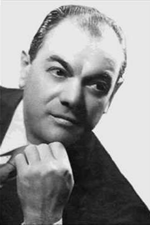
Here is my collection of milonga tandas by Francisco Canaro.
| Song | Orchestra | Cantor/Singer | Year | Type |
| Largas Las Penas | Francisco Canaro | Roberto Maida | 1937 | Milonga |
| Milonga del 900 | Francisco Canaro | Ernesto Famá | 1933 | Milonga |
| Milonga Sentimental | Francisco Canaro | Ernesto Famá | 1933 | Milonga |
| Tangón (Nueva Danza) | Francisco Canaro | Roberto Maida | 1935 | Milonga |
| Listen to this tanda | ||||
| Largas Las Penas | Francisco Canaro | Roberto Maida | 1937 | Milonga |
| Milonga Criolla | Francisco Canaro | Roberto Maida | 1936 | Milonga |
| Silueta Porteña | Francisco Canaro | Roberto Maida | 1936 | Milonga |
| Milonga de Mis Amores | Francisco Canaro | 1937 | Milonga | |
| La Milonga de Mis Tiempos | Francisco Canaro | 1938 | Milonga | |
| Milongón | Francisco Canaro | 1938 | Milonga | |
| Milonga Brava | Francisco Canaro | Roberto Maida | 1938 | Milonga |
| Listen to this tanda | ||||
| La Milonga de Buenos Aires | Francisco Canaro | Ernesto Famá | 1939 | Milonga |
| Reliquias Porteñas | Francisco Canaro | 1938 | Milonga | |
| No Hay Tierra Como La Mía | Francisco Canaro | Ernesto Famá | 1939 | Milonga |
| Milonga Brava | Francisco Canaro | Roberto Maida | 1938 | Milonga |
| Después de Querela Tanto | Francisco Canaro | Ernesto Famá | 1940 | Milonga |
| Historia Sentimental | Francisco Canaro | 1938 | Milonga | |
| Mi Buenos Aires | Francisco Canaro | 1938 | Milonga | |
| Milonga Brava | Francisco Canaro | Roberto Maida | 1938 | Milonga |
| La Milonga de Mis Perros | Francisco Canaro | Carlos Roldán | 1942 | Milonga |
| Cuando Un Viejo Se Enamora | Francisco Canaro | Carlos Roldán | 1942 | Milonga |
| Soy Un Porteño | Francisco Canaro | Carlos Roldán | 1942 | Milonga |
| Reliquias Porteñas | Francisco Canaro | 1938 | Milonga | |
| Caran Can Fú | Francisco Canaro | 1939 | Milonga | |
| Milongueando | Francisco Canaro | Ernesto Famá | 1941 | Milonga |
| El Llorón | Francisco Canaro | Ernesto Famá | 1944 | Milonga |
| La Naranja Nació Verde | Francisco Canaro | Carlos Roldán y Héctor Castel |
1959 | Milonga |
| El Torito | Quinteto Pirincho | 1950 | Milonga | |
| La Trampera | Quinteto Pirincho | 1955 | Milonga | |
| Arrabalera | Quinteto Pirincho | 1955 | Milonga | |
| Corralera | Quinteto Pirincho | 1956 | Milonga | |
| Se Dice de Mí | Quinteto Pirincho | 1954 | Milonga | |
| Corralera | Quinteto Pirincho | 1956 | Milonga | |
| Orillera | Quinteto Pirincho | 1960 | Milonga | |
| Milonga del Tiempo Heroico | Quinteto Pirincho | 1957 | Milonga |
This tanda is not so much alternative as it is not traditional. These are some modern milongas which are lots of fun to dance to. I have always loved Al Galope but always found it difficult to fit into a tanda. This version of Milonga Sentimental is just so beautiful. In fact every song on Patio de Tango is wonderful especially their versions of Malena and Palomita Blanca. The star of the set is the wonderful Morena by Estaban Morgado.
Here is my collection of milonga tandas, with two exceptions. Francisco Canaro recorded so many great milongas that I have them all listed here. I have also created collections of candombe milongas and mixed orchestra milonga tandas and Alternative Milongas.
| Song | Orchestra | Cantor/Singer | Year | Type |
| Rodolfo Biagi Milonga Tanda Collection I I usually use the first 3 from this tanda collection. |
||||
| Campo Afuera | Rodolfo Biagi | Teofilo Ibanez | 1943 | Milonga |
| Picante | Rodolfo Biagi | 1945 | Milonga | |
| Flor de Montserrat | Rodolfo Biagi | Alberto Amor | 1942 | Milonga |
| Miguel Caló Tanda | ||||
| Milonga Antigua | Miguel Caló | Raúl Berón | 1942 | Milonga |
| Milonga Que Peina Canas | Miguel Caló | Raúl Berón | 1942 | Milonga |
| Bien Criolla y Bien Porteña | Miguel Caló | Luis Tolosa y Raúl Iriarte | 1945 | Milonga |
| Azabache | Miguel Caló | Raúl Berón | 1942 | Milonga |
| Angel d'Agostino & Angel Vargas Tandas | ||||
| Listen to this tanda | ||||
| El Porteñito | Angel d'Agostino | Angel Vargas | 1943 | Milonga |
| Asi Me Gusta A Mi | Angel d'Agostino | Angel Vargas | 1942 | Milonga |
| Entre Copa y Copa | Angel d'Agostino | Angel Vargas | 1942 | Milonga |
| Zapatitos de Raso | Edelmiro d'Amario | Angel Vargas | 1956 | Milonga |
| Compadreando | Angel d'Agostino | Angel Vargas | 1941 | Milonga |
| Señores, Yo Soy Del Centro | Angel d'Agostino | Angel Vargas | 1945 | Milonga |
| Entre Copa y Copa | Angel d'Agostino | Angel Vargas | 1942 | Milonga |
| Asi Me Gusta a Mi | Angel d'Agostino | Angel Vargas | 1942 | Milonga |
| Juan d'Arienzo Collections |
||||
| La Puñalada | Juan d’Arienzo | 1937 | Milonga | |
| De Pura Cepa | Juan d’Arienzo | 1935 | Milonga | |
| El Esquinazo | Juan d’Arienzo | 1938 | Milonga | |
| Milonga Vieja Milonga | Juan d’Arienzo | 1937 | Milonga | |
| El Temblor | Juan d’Arienzo | Alberto Echagüe | 1938 | Milonga |
| Estampa de Varon | Juan d’Arienzo | Alberto Echagüe | 1938 | Milonga |
| De Antaño | Juan d’Arienzo | Alberto Echagüe | 1939 | Milonga |
| La Cicatriz | Juan d’Arienzo | Alberto Echagüe | 1939 | Milonga |
| Milonga Vieja Milonga | Juan d’Arienzo | 1937 | Milonga | |
| Milonga del Corazón | Juan d’Arienzo | Alberto Echagüe | 1938 | Milonga |
| Milonga del Recuerdo | Juan d’Arienzo | Alberto Echagüe | 1939 | Milonga |
| Milonga Querida | Juan d’Arienzo | Alberto Echagüe | 1938 | Milonga |
| Corrales Viejos | Juan d’Arienzo | 1943 | Milonga | |
| La Espuela | Juan d’Arienzo | 1946 | Milonga | |
| Milonga Que Peina Canas | Juan d’Arienzo | Armando Laborde | 1952 | Milonga |
| La Puñalada | Juan d’Arienzo | 1951 | Milonga | |
| Carlos di Sarli Collections | ||||
| La Mulateada | Carlos di Sarli | Roberto Rufino | 1941 | Milonga |
| Pena Mulata | Carlos di Sarli | Roberto Rufino | 1941 | Milonga |
| Zorzal | Carlos di Sarli | Roberto Rufino | 1941 | Milonga |
| Pueblera | Carlos di Sarli | Jorge Durán | 1946 | Milonga |
| Entre pitada y pitada | Carlos di Sarli | Alberto Podestá | 1942 | Milonga |
| Cuando un viejo se enamora | Carlos di Sarli | Roberto Rufino | 1942 | Milonga |
| Yo soy de San Telmo | Carlos di Sarli | Roberto Rufino | 1943 | Milonga |
| Maldonado | Carlos di Sarli | Roberto Rufino | 1943 | Milonga |
| Edgardo Donato Tandas |
||||
| Ella Es Así | Edgardo Donato | Horacio Lagos | 1938 | Milonga |
| Sacale Punta | Edgardo Donato | Horacio Lagos & Randona | 1938 | Milonga |
| Porteña Linda | Edgardo Donato | Horacio Lagos | 1940 | Milonga |
| La Milonga Que Faltaba | Edgardo Donato | Horacio Lagos | 1938 | Milonga |
| El Torito | Edgardo Donato | 1939 | Milonga | |
| Cara Negra | Edgardo Donato | Horacio Lagos | 1942 | Milonga |
| Cacareando | OTV | Carlos Lafuente | 1933 | Milonga |
| Mi Vieja Linda | Emilio Pellejero | 1941 | Milonga | |
| Papas Calientes | Edgardo Donato | 1937 | Milonga | |
| Corrales Viejos | Edgardo Donato | 1934 | Milonga | |
| Papas Calientes | Edgardo Donato | 1937 | Milonga | |
| El Lengue | Edgardo Donato | 1940 | Milonga | |
| Cara Negra | Edgardo Donato | 1942 | Milonga | |
| Pedro Laurenz Collections |
||||
| Listen to this tanda. | ||||
| Milonga Compadre | Pedro Laurenz | J.C. Casas | 1938 | Milonga |
| La Vida Es Una Milonga | Pedro Laurenz | Martin Podesta | 1941 | Milonga |
| Milonga de Mis Amores | Pedro Laurenz | 1944 | Milonga | |
| La Vida Es Una Milonga | Pedro Laurenz | Martin Podesta | 1941 | Milonga |
| Milonga de Mis Amores | Pedro Laurenz | 1944 | Milonga | |
| Maldonado | Pedro Laurenz | Alberto Podesta | 1943 | Milonga |
| Milonga de Mis Amores | Pedro Laurenz | Hector Farrel | 1937 | Milonga |
| Milonga Compadre | Pedro Laurenz | J.C. Casas | 1938 | Milonga |
| Yo Soy De San Telmo | Pedro Laurenz | Alberto Podesta | 1943 | Milonga |
| Francisco Lomuto The first song is great, but the last two are very very fast. |
||||
| Qué Tiempo Aquel | Francisco Lomuto | Jorge Omar | 1938 | Milonga |
| Parque Patricios | Francisco Lomuto | Fernando Díaz | 1941 | Milonga |
| No Hay Tierra Como La Mía | Francisco Lomuto | Fernando Díaz | 1939 | Milonga |
| Orchestra Tipica Victor The first 3 make a very homogeneous tanda. This version of Milonga Sentimental is amazing and has very similar rhythm to Cacareando. |
||||
| Cara Negra | Edgardo Donato | Horacio Lagos | 1942 | Milonga |
| Cacareando | OTV | Carlos Lafuente | 1933 | Milonga |
| Milonga Sentimental | Mercedes Simone | 1932 | Milonga | |
| Milonga de Los Fortines | OTV | Mariano Balcarce | 1937 | Milonga |
| La Naranja Nacio Verde | Feliciano Brunelli | Oscar Valeta | 1943 | Milonga |
| Anibal Troilo Tandas | ||||
| Listen to this Tanda | ||||
| Del Tiempo Guapo | Aníbal Troilo | Francisco Fiorentino | 1941 | Milonga |
| Con Toda La Voz Que Tengo | Aníbal Troilo | Francisco Fiorentino | 1941 | Milonga |
| Ficha de Oro | Aníbal Troilo | Francisco Fiorentino | 1942 | Milonga |
| Papá Baltasar | Aníbal Troilo | Francisco Fiorentino | 1942 | Milonga |
| Mano Brava | Aníbal Troilo | Francisco Fiorentino | 1941 | Milonga |
| El Barrio del Tambor | Aníbal Troilo | Alberto Marino | 1943 | Milonga |
| Con Permiso | Aníbal Troilo | Alberto Marino | 1944 | Milonga |
| Hector Varela Collection I Varela is rarely played at milongas. This set is fairly complex. I love it, but only play it late at night when there are only good dancers left that love milonga. |
||||
| Silueta Portena | Héctor Varela | Argentino Ledesma | 1960s | Milonga |
| Azucar, Pimienta y Sal | Héctor Varela | Fernando Soler, Jorge Falcon | 1960s | Milonga |
| Con Flauta y Guitarra | Héctor Varela | Jorge Falcon | 1960s | Milonga |

The first generation of tango musicians are commonly referred to as "La Guardia Vieja" (The Old Guard). The first Period of "La Guardia Vieja" lasted from approximately 1895 to 1910. These songs are a type of habanera blended with African and European music and are sometimes referred to as "tango-habanera," "tango criollo" or "tango-milonga."
This period saw:
The music originated in the "Rioplatenese" or Río de la Plata region of Argentina and Uruguay. Some of the origins of the music would be candombe, vals criollo, habanera, flamenco, polka, milonga (different from the milonga we know today and was a type of "battle" poetry), mazurka and contradanse. In essence, you had European immigrants with their instruments being influenced heavily by Latin American and African music.
It is true that only about 8,000 black argentines existed out of a population of over 400,000 in 1887, but all it took was a few to have a great impact on tango. The best example of this was Leopoldo Ruperto Thompson. Get this, he was a bass player who played with Firpo, Canaro, Arolas, de Caro and Cobián. Many of the first bandoneon players and guitarists were black. Also, some of the earliest composers of tango including Mendizábal and Carlos Posadas, as well as many of the earliest dancers and teachers.
At this time Tango was played by solo guitar or piano, small ensembles (conjuntos) and municipal marching bands. The ensembles were usually trios and would often consist of some combination of flute, clarinet, guitar and/or violin. The guitar would often play the habanera rhythm while the flute, clarinet and/or vilolin played the melody. Sometimes, these groups would be accompanied by male or female singers. They would play in cafés, beer houses, courtyards of conventillos (poor apartment houses) and also in brothels. The music would also have been played around the city by organitos or organ-grinders who went around the city playing portable player-organs.
Towards the end of this period we also saw the signature instrument of tango, the bandoneon, introduced to the ensembles. The bandoneon was a concertina type of instrument created in Germany for churches that could not afford an expensive organ. It made its way over to Argentina and Uruguay with the huge influx of immigrants.
 |
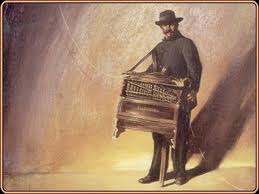 |
During this time, tango begins to take on structure. In 1897, Anselmo Rosendo Menizábal composed, "El entrerriano (The Man from Between the Rivers)" which was the first tango structured in three distinct sections. The 1st and 3rd sections had 16 measures and the 2nd measure had thirty-two measures.
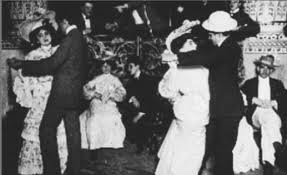 In the early 1900s, many academias and cabarets began to open around the city. Academias were places were people could learn the choreography of tango and other dances. Cabarets were public places where people could dance and play tango. Armenonville, at the corner of Avenida Alvear y Table, was one of the first of these places. Other establishments were also opening and promoting tango like Hansens which was a restaurant/café on Avenida Sarmientos. The picture on the left was taken in March of 1905 at a carnival at the Pabellón de las Rosas (Rose Pavillion), a popular dance venue in Buenos Aires.
In the early 1900s, many academias and cabarets began to open around the city. Academias were places were people could learn the choreography of tango and other dances. Cabarets were public places where people could dance and play tango. Armenonville, at the corner of Avenida Alvear y Table, was one of the first of these places. Other establishments were also opening and promoting tango like Hansens which was a restaurant/café on Avenida Sarmientos. The picture on the left was taken in March of 1905 at a carnival at the Pabellón de las Rosas (Rose Pavillion), a popular dance venue in Buenos Aires.
This period also saw men dancing with other men. The primary reasons for this was that men greatly outnumbered women and so the women had their pick of the men to dance with. So, the men would get together and practice and learn from one another in order to improve so that the could attract the few women dancers. This was a time when women and men could not associate as easily as today.
.jpg)
Many early pioneers of rioplatense tango travelled to Europe including Angel Villoldo, Alfredo Gobbi, and his wife, Flora Hortensia Rodriguez to record ind France and Germany. Below are some of the earliest recordings of tango. These recordings are from vinyl LPs and 78s. I am working on getting them all recorded and posting as much historical information about them as possible.
Between 1906 and 1910, 850,000 immigrants arrived in Buenos Aires and the population grew to 1,500,000, setting the stage for the next period of tango's growth.
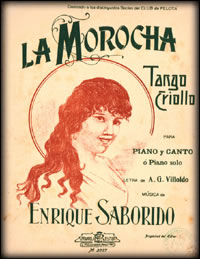 “La Morocha” (?)
“La Morocha” (?)
Composer: Enrique Saborido
Performed by: Recording of an orginal Barrel Organ (Organito)
The original sheet music describes the song as "tango criollo." There is some debate about whether or not this or "el choclo" was the first tango to be exported to Europe. Saborido travelled to Paris and was there in 1911 teaching people how to play and dance tango. Of course, this version is an instrumental, but Angel Villoldo did add lyrics to the song.
More on Enrique Saborido: http://www.todotango.com/
More on "La Morocha:" http://www.todotango.com/
"El Sargento Cabral" (1907)
Composer: Manuel O. Campoamor
Performed by: Banda de la Guardia Republicana de Paris
.gif)
The pianist and composer Manuel O. Campoamor numbered all his tangos and "El Sargento Cabral", dating from 1898 or 1899 is number 1.
Campoamor was born on November 7, 1877 in Montevideo, Uruguay, but he grew up in Buenos Aires, Argentina. He learned to play the piano by ear and never learned to write music. He composed tangos from 1898 to 1905 and kept playing piano publicly until 1922, but according to his wife he would still play at home every day until his death in 1941 of Lung Cancer. He is quoted as saying, "I didn't compose any more and don't even think of doing it; I neither have the enthusiasm nor the time to devote to that. Today the output is overwhelming and the number of composers is great. The present generation has adopted a different beat for tango, which is warmly welcome by the public; we, those who feel tango in quite a different way, have to withdraw to allow the new trends to express this new sensitivity."
"El Sargento Cabral" was published in 1899 by Gath & Chaves house where Campoamor worked for 25 years, eventually becoming manager.
It was edited by J. A. Medina e Hijo and it as dedicated to the composer Leopoldo Corretjer. According to the author, this work owes its title to a common occurrence in local dance spots of the time. Following a competition someone from the winning side would exclaim, "We have beat the enemy!" in parody of what Sargent Cabral said shortly before his own death in the battle of San Lorenzo.
The recording of Paris' Republican Band belongs to a series of recordings made specifically for the recording house, Gath & Chaves. They sent several pioneers of rioplatense tango to Europe including Angel Villoldo, Alfredo Gobbi, and his wife, Flora Hortensia Rodriguez to record because there was no recording studio in Buenos Aires.
Campoamor also worked as a pianist in the famous house of Maria "La Vasca" which can still be found at the corner of Carlos Calvo Street and Jujuy Street.
For more information on Campoamor visit: http://www.todotango.com/
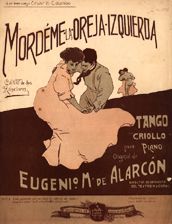 "Mordeme la oreja izquierda" (Bite my left ear) (1908)
"Mordeme la oreja izquierda" (Bite my left ear) (1908)
Composer: Eugenio M. de Alarcon
Performed by Banda Española
This edition of the tango dates from 1906 and belongs to the composer himself, who dedicated it "Al amigo Cesar H. Colombo" (To the friend Cesar H. Colombo). It has the odd subtitle "Canto de dos ruiseñores" (A song of two nightingales) and the classification of "tango criollo." A footnote on the cover warns that any sample that does not have the author's signature should be considered a falsification.
Alarcon, director of the national theater orchestra, enjoyed using many italianisms when indicating how to express the music; on this piece one can see words such as "expressivo", "legatissmo", "scelti", "ben ritmato", etc.
For more information: http://www.todotango.com/
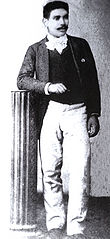 "El Club Z" (1908)
"El Club Z" (1908)
Composer: Anselmo Rosendo Mendizabal
Performed by: Orquesta del Teatro Apolo Dir: Enrique Cheli
The "Z Club" was composed of a group of revelers headed by Esteban Banza and J. Guidobono. This was an exclusive group formed by forty individuals with the sole purpose of organizing a monthly dance for its members. This group existed from the end of the nineteenth century to the first decade of the twentieth century. The dances were generally held in the house of Maria La Vasca, and it was rented for the entire night for 3 pesos per hour per person. The Afro-Argentine pianist and composer Mendizabal was the usual musician, both as a soloist as well as when he played with his band, which was composed of two violins, a flute, a piano and two guitars. Mendizabal composed many tangos including "El Club Z" where an instrumental call and response surmounts a habanera accompaniment.
Due to prejudices of the time, Mendizabal signed his tangos with the pseudonym "A. Rosendo". The original score included in this anthology is edited by the author by the musical press Ortelli Hnos. Has the dedication, "A los distinguidos socios del Z Club" (To the distinguished members of the Z Club).
For more information: http://www.todotango.com/english/crea...
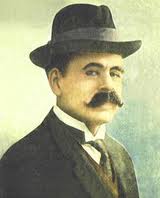 “El Pechador” (1909)
“El Pechador” (1909)
Composed by: Angel Gregorio Villoldo
Performed by: Linda Thelma (canto) y Arturo de Siano (piano)
Edited by the house David Poggi e Hijo, it was dedicated by Villoldo “Al celebrado autor nacional don Nemesio Trejo” (to the celebrated national author Mr. Nemesio Trejo), who was the singer and author of comic sketches (1862-1916); it was a popular tango in its time and it was also recorded by Alfredo Gobbi.
Like most, if not all, of Villoldo’s lyrics they are written in the first person and exalt the virtues of the compadrito. Although it may seem inappropriate this title is sung by a woman, the singer Linda Thelma, who has deep roots in Spanish tiples [I have no idea what this is]. She was accompanied on many an occasion by Villoldo himself while recording. Arturo de Siano, a musician who plays with Linda Thelma in this version, was a prominent musician in the theater.
More info on Angel Gregorio Villoldo: http://www.todotango.com/english/creadores/avilloldo.html
More info on Linda Thelma: http://www.todotango.com/english/creadores/lthelma.asp
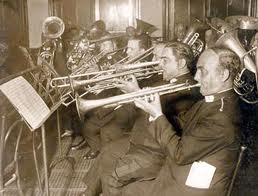 “El Purrete (The Kid)” (1909)
“El Purrete (The Kid)” (1909)
Composed by: Jose Luis Roncallo
Performed by: Banda de la Policía de Beunos Aires Dir: Mtro. A Rivara
Basically, all bands incorporated tangos into their repertoires during the first two decades of the century. You can hear the habanera being heavily dramatized as the cymbals clash during the song. These types of bands reached their peak during these years as is demonstrated by the elevated number of recordings made. Some of the most well-known ones include: the 1st Infantry Regiment, the 5th Infantry regiment, the Atlanta, and the Buenos Aires Police.
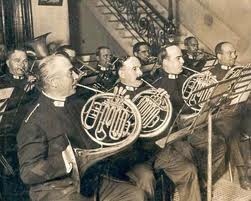 “El Purrete”, edited by Breyer Hnos. and dedicated to “El Senor Eduardo Oliveri” (Mr. Eduardo Oliveri) was the first tango written by this author. His style was methodical and consistent with a musician trained in a conservatory. According to unverified claims, the song dates from 1901 and the score dates from some time after, 1903 to 1904.
“El Purrete”, edited by Breyer Hnos. and dedicated to “El Senor Eduardo Oliveri” (Mr. Eduardo Oliveri) was the first tango written by this author. His style was methodical and consistent with a musician trained in a conservatory. According to unverified claims, the song dates from 1901 and the score dates from some time after, 1903 to 1904.
“La Bicicleta” (1909)
Composer: Angel Gregorio Villoldo
Performed by: Angel Villoldo (canto y castañuelas) y Manuel O. Campoamor (piano)
The primitive form of singable rioplatense tango suffered great influences from Spanish zarzuela tango. This is very clearly detectable in the version of “La bicicleta” by Angel G. Villoldo. It has a piano accompaniment by Manuel O. Campoamor purely for melodic purposes as well as castanets played by Villoldo.
Cycling and pelota vasca were the favorite sports during 1895 and 1910, where one could find extensive bicycle caravans traveling to be exhibited in the forests of Palmero after first riding in the city center.
According to Robert Farris Thompson, "Villoldo's 'La bicicleta' (The Bicycle) of 1909 began, nobly, to mix cultures. From the famus black payador Gabino Ezeiza, Villoldo borrows jump-cuts from singing to speech. He hits certain words, like damas and ramas, with flamencolike trills, Arabized melismas that add savor to rhyme. And while he's singing, Villoldo plays castanets!"
More info on Villoldo: http://www.todotango.com/english/creadores/avilloldo.html
More info on Campoamor: http://www.todotango.com/english/crea...
“El Porteñito” (1909)
Composer: Angel Gregorio Villoldo
Performed by: Andrée Vivianne (canto) y orquesta
More info on Villoldo: http://www.todotango.com/english/creadores/avilloldo.html
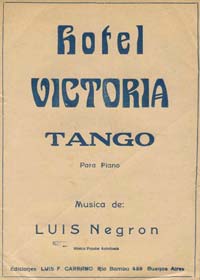 “Gran Hotel Victoria” (1910)
“Gran Hotel Victoria” (1910)
Composer: Feliciano Latasa
Performed by: Estudiantina Centenario (trio de bandurrias y guitarra) Dir: Vicente Abad
For more information: http://www.todotango.com/english/biblioteca/cronicas/leyenda_Hotel_Victoria.asp
"Joaquina" (1911)
Composer: Juan Bergamino
Performed by: Manuel O. Campoamor (solo piano)
